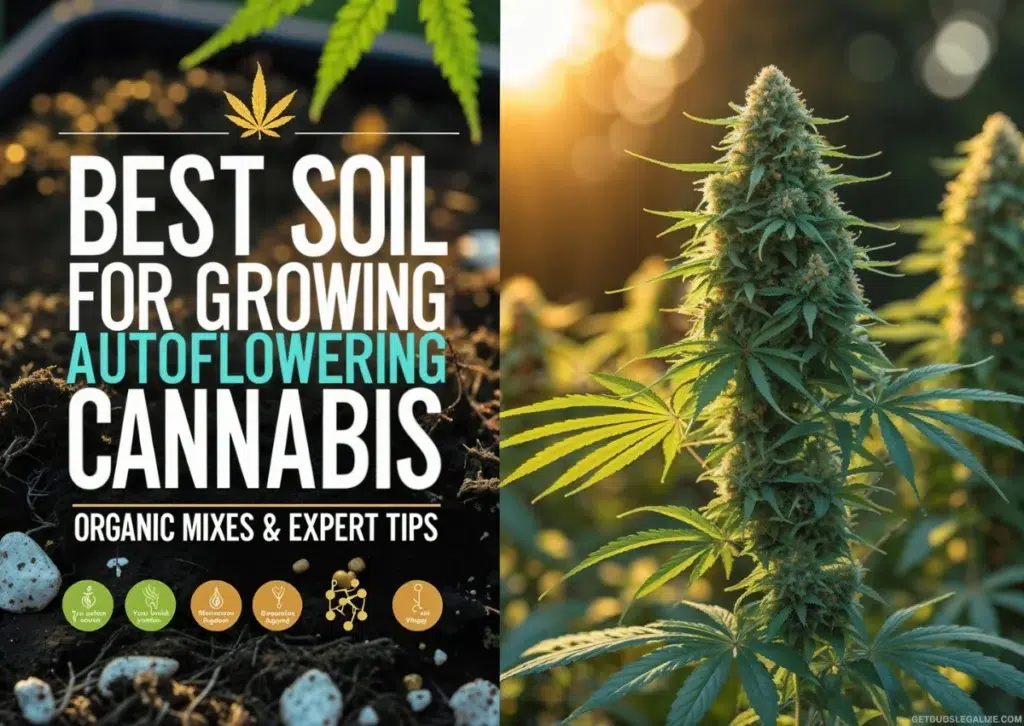Ultimate Guide to Cannabis Hydroponics: Growing Tips & Techniques
Hydroponics revolutionizes cannabis cultivation by harnessing the power of water and nutrients, eliminating the need for soil. Within this innovative system, cannabis plants thrive in a nutrient-rich solution, leading to accelerated growth and robust yields.
In a hydroponic setup, cannabis plants are housed in buckets or baskets filled with an inert growing medium, suspended over a reservoir teeming with nutrient-infused water. Aeration is facilitated through the use of air stones, ensuring optimal oxygenation for plant roots.
This adaptable model encompasses various configurations and systems, catering to the diverse preferences of growers.
The History of Hydroponics
Contrary to popular belief, hydroponic cultivation boasts a rich history dating back thousands of years. Ancient wonders like the Hanging Gardens of Babylon, constructed around 600 BCE, are believed to have employed hydroponic techniques to nurture plants in arid environments. Similarly, the Aztecs utilized floating rafts to cultivate crops atop Lake Tenochtitlan during the 10th and 11th centuries, showcasing early innovations in hydroponic agriculture.
In more recent history, the pioneering work of English scientist John Woodward in 1699 demonstrated the accelerated growth of spearmint plants in water mixed with soil, laying the foundation for modern hydroponic practices.
The Advantages of Cannabis Hydroponics Growing
Experienced growers attest to the remarkable speed and vigor of cannabis plants cultivated through hydroponics. With growth rates 30–50% faster than soil-grown counterparts and increased yields, hydroponic cultivation offers unparalleled advantages. The direct uptake of nutrients by plant roots in a hydroponic system eliminates the need for nutrient exploration through the soil, conserving energy that can be redirected toward robust growth.
Stay tuned for the continuation of this guide, where we delve deeper into the benefits and techniques of cannabis hydroponics growing, accompanied by insightful diagrams to enhance your understanding.
Exploring the Contrast: Active vs. Passive Hydroponic Systems
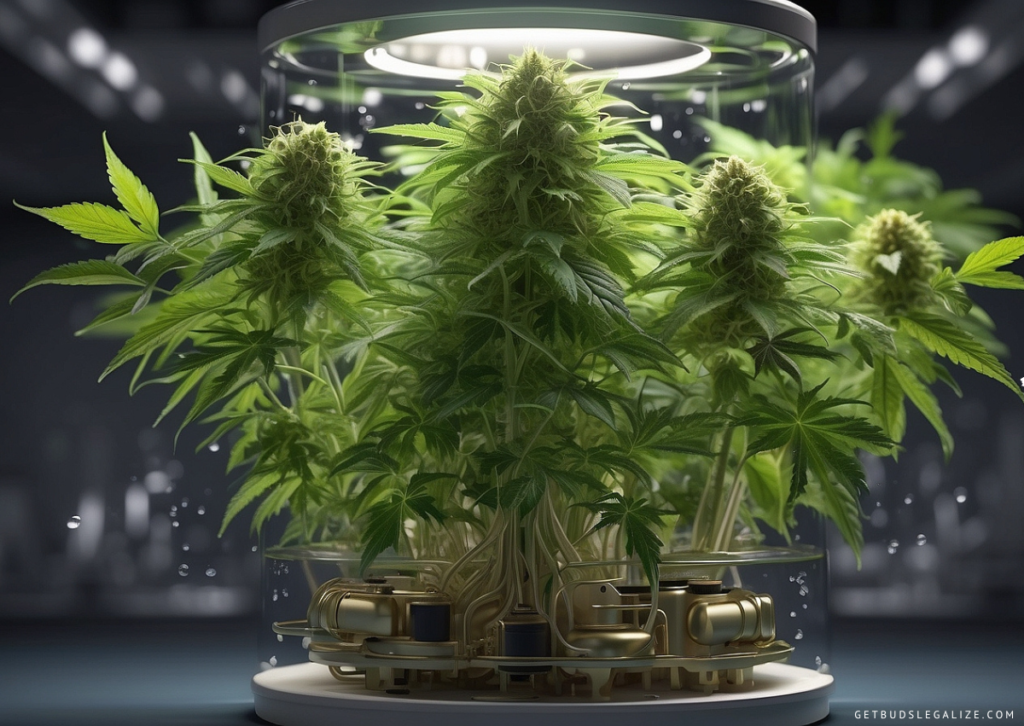
In the realm of hydroponics, systems are categorized as either active or passive, each offering distinct advantages and mechanisms. Let’s explore the key differences between them.
Active Hydroponic Systems:
Active hydroponic setups employ technological aids such as electric pumps and air stones to facilitate the movement of nutrient solutions and oxygenation of water. These systems are adept at providing precise control over plant nutrition and hydration.
Types of Active Hydroponic Systems:
- DWC
- Ebb and Flow
- NFT
- Drip System
- Aeroponics
Benefits of Active Hydroponic Systems:
- Ideal for larger-scale operations
- Water-efficient
- Facilitate ample oxygen supply to roots
- Automation options available for reduced manual labor
Passive Hydroponic Systems for Cannabis:
In contrast, passive hydroponic systems embrace simplicity, relying on basic mechanisms to deliver water and nutrients to plant roots without the need for electric pumps.
Types of Passive Hydroponic Systems:
- The Kratky Method
- Wick System
Benefits of Passive Hydroponic Systems:
- Cost-effective and straightforward to set up
- Perfect for beginners entering the realm of hydroponic growing
- Minimal electricity consumption
- Great introductory option for those exploring water-based cultivation methods
Is Passive Hydroponics Superior to Hand Watering?
The efficacy of passive hydroponic systems versus hand watering largely depends on the specific system employed. While some systems like the Kratky method eliminate the need for manual watering entirely, others such as wick systems, when integrated with soil, offer consistent hydration and reduced risk of overwatering. However, occasional intervention may be necessary for large or thirsty plants.
In conclusion, both active and passive hydroponic systems offer unique benefits tailored to different cultivation needs. Whether opting for the simplicity of passive systems or the technological prowess of active setups, hydroponic growers have a diverse array of options to suit their preferences and growing objectives.
The Cost of Growing with Hydroponics
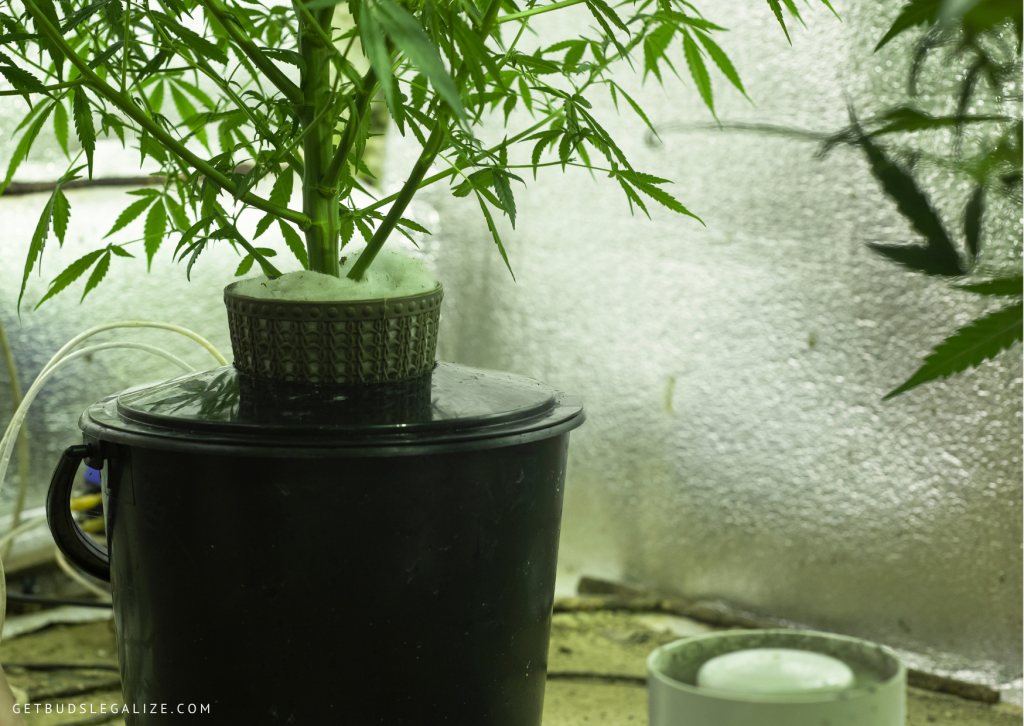
The financial commitment for a hydroponic system varies greatly depending on budget constraints. Options range from simple plastic buckets to more advanced self-draining and flooding systems.
For those looking for convenience and efficiency, investing in an affordable hydroponic starter kit proves beneficial. These kits come complete with all the materials you need to take your plants from seedling to harvest.
Typically, such kits can be purchased for around £200 (€235), providing an affordable entry point into hydroponic growing.
Components Required for Crafting Your Hydroponic Setup
Creating your hydroponic system can be a rewarding endeavor, offering customization and cost-saving opportunities. Below is a concise guide outlining the essential equipment needed for constructing a basic indoor setup. By sourcing the items individually, you can prioritize investments in critical components like lighting while optimizing costs elsewhere.
Here’s what you’ll need:
- Lighting (LED or HPS)
- Lighting hangers
- Grow tent
- Hydroponic reservoir and tray
- Airstone and pump
- Growing medium (e.g., coco coir)
- Net mesh planting pots
- Seeds
- Ventilation fan and ducting tubes
- Carbon filter
- Oscillating fan
- Hydroponic nutrients
- pH and TDS/EC meters
- Thermometer/Hygrometer
With this list in hand, you can begin assembling your DIY hydroponic system, tailored to meet your specific needs and preferences.
Selecting the Right Growing Medium to Kickstart Your Hydroponic Journey
Now that we’ve delved into the rich history and myriad benefits of hydroponic cultivation, let’s embark on the first step: choosing a growing media. This crucial substance serves as the anchor for the intersection of the stem and roots, providing support while allowing roots to access water and nutrients. With a plethora of options available, experimentation is key to finding the perfect fit for your hydroponic system.

1. Clay Pebbles: Widely favored among hydroponic growers, clay pebbles offer affordability and reliability. These lightweight, porous pellets retain moisture effectively while ensuring adequate air circulation. Ideal for beginners and seasoned growers alike, clay pebbles also contribute to pH stability, optimizing nutrient absorption by cannabis plants.
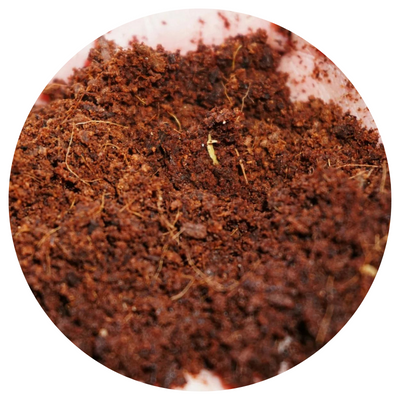
2. Coco Coir: Derived from coconut husks, Coco Coir stands out for its versatility and eco-friendliness. Resistant to mold, pests, and diseases, this medium provides excellent water retention and drainage. Coco coir is forgiving for novice growers, easily rehydrated if it dries out, and fosters robust root development.
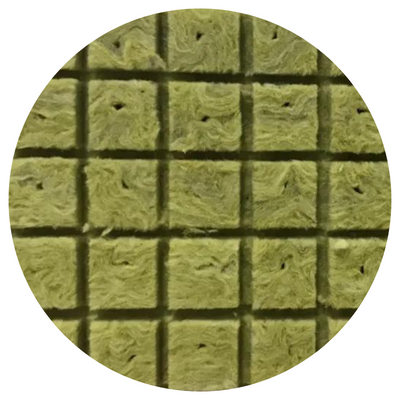
3. Rockwool: Crafted from melted and spun rock fibers, Rockwool is a synthetic medium prized for its water and air retention properties. Available in various shapes and sizes, including cubes and slabs, Rockwool ensures a balanced environment for plant roots. However, meticulous pH balancing and handling are essential to prevent interference with nutrient uptake.
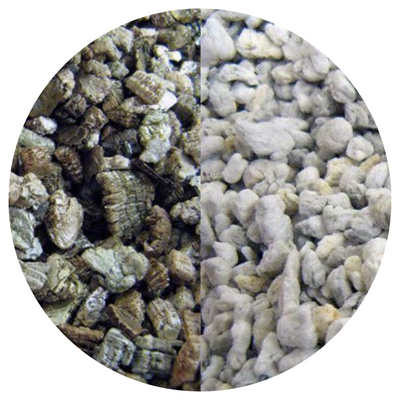
4. Perlite and Vermiculite: Perlite and vermiculite, lightweight minerals commonly used in soil amendments, serve as versatile hydroponic mediums. Perlite’s volcanic origin creates air pockets within the medium, enhancing aeration, while vermiculite’s water and nutrient retention properties promote root growth. pH-neutral and inert, both substances are compatible with hydroponic cultivation.
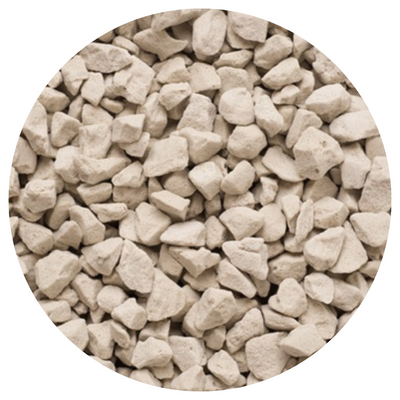
5. Expanded Clay Aggregate (Growstones): Composed of recycled glass, expanded clay aggregate, or growstones, offers exceptional drainage, aeration, and moisture retention. Lightweight and pH-neutral, growstones ensure optimal oxygenation of roots while maintaining moisture levels. Resistant to compaction and degradation, they provide long-lasting performance in hydroponic systems.
Choosing the Right Hydroponic Growing System for Maximum Plant Performance
Once you’ve determined the ideal growing medium, the next step is selecting a hydroponic setup tailored to your specific requirements. While these systems share the commonality of utilizing nutrient-rich water solutions, their designs can vary significantly, impacting factors such as water exposure and circulation. While pre-made systems are readily available, individuals with DIY skills can construct them using basic materials like buckets, drills, pumps, and air stones.
1. The Kratky Method:
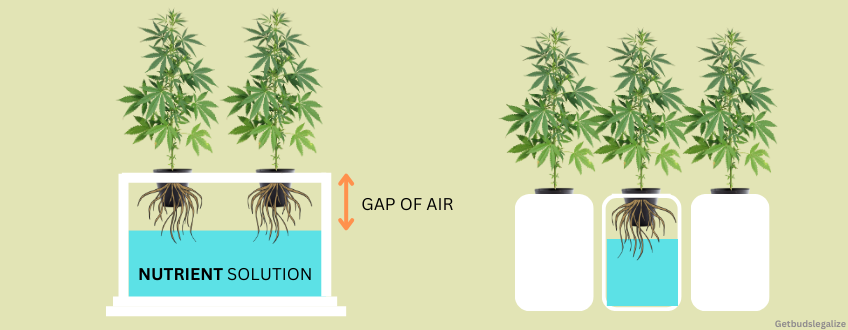
The Kratky method presents a budget-friendly and straightforward approach to hydroponic cultivation. This method involves using basic materials such as buckets and plastic boxes. Plants are positioned in net cups inserted into a lid, allowing roots to extend into a nutrient solution below. Upper root oxygenation is achieved through an air gap between the solution’s surface and the lid, eliminating the need for an air stone.
2. Deep Water Culture (DWC):
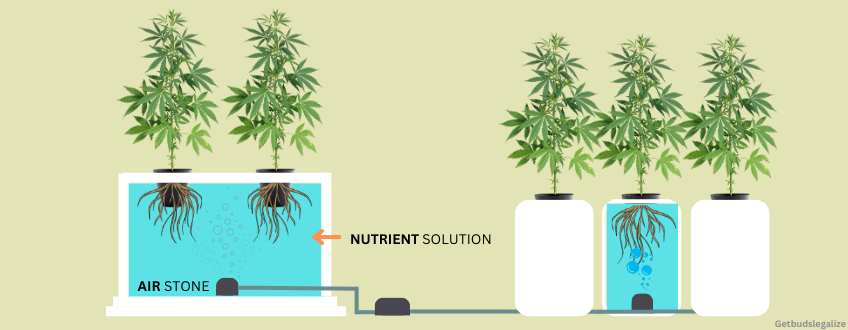
DWC systems serve as active counterparts to the Kratky method. They consist of a single reservoir filled with nutrient solution, with plants placed in net cups on a floating Styrofoam sheet. Unlike the Kratky method, DWC systems utilize an air stone to continuously aerate the solution, ensuring optimal root oxygenation.
3. Ebb and Flow (Flood and Drain):
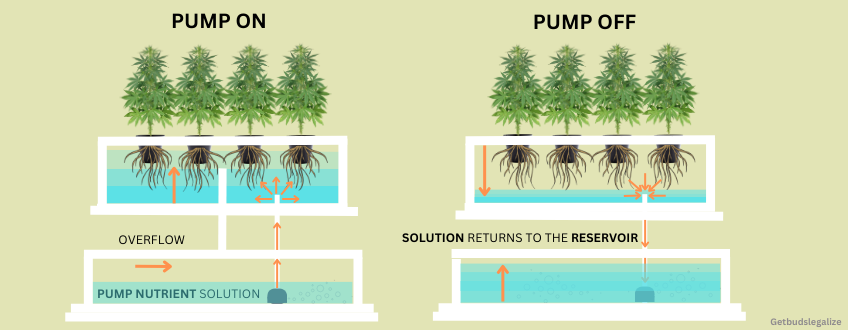
Ebb and flow systems feature periodic water movement, with multiple buckets suspended over a growing tray equipped with water inlet and outlet connections. During the pump cycle, water enriched with nutrients floods the growing tray, providing oxygen and nutrients to the roots before draining back into the external tank.
4. Drip System:
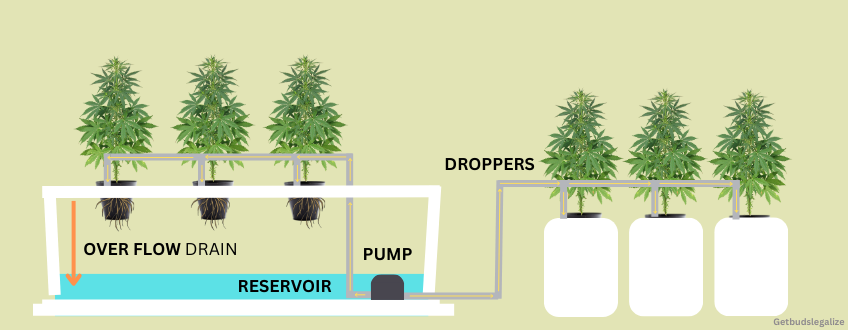
Similar to drip irrigation in soil, hydroponic drip systems involve plants placed in a tray filled with a growing medium. Each plant receives a constant drip feed of water from individual pipes connected to an external tank. Excess water drips back into the tank, ensuring continuous root aeration.
5. Nutrient Film Technique (NFT):
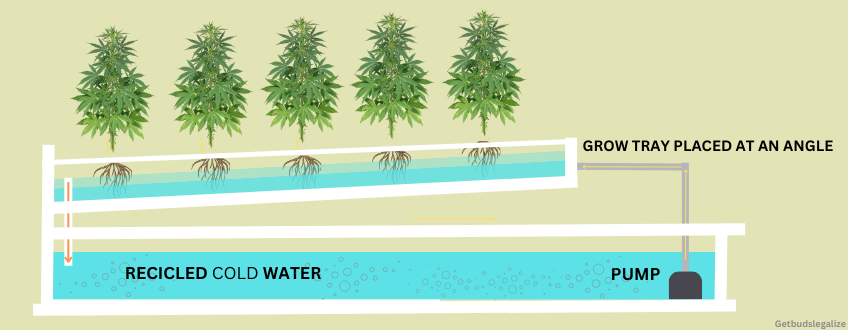
NFT delivers a constant stream of water and nutrients to the roots, with the growing tray positioned at a slight angle to facilitate solution flow. An electric pump circulates the solution from the reservoir, promoting nutrient uptake while maintaining root oxygenation.
6. Wick System:
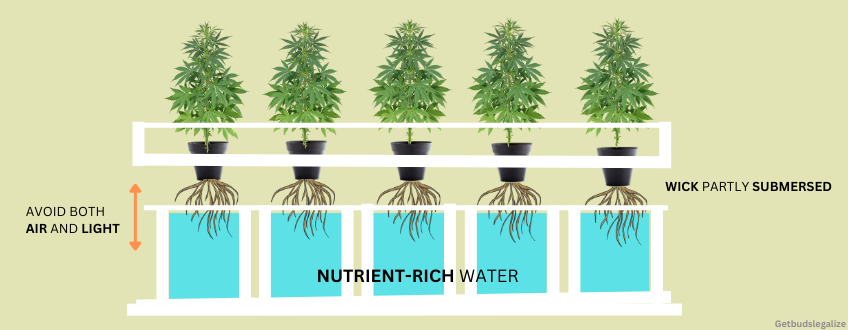
The wick system employs capillary action to passively transport nutrient solution from a separate reservoir to the roots. Growers can opt for soil or soilless media like coco coir, both allowing oxygen to reach the roots without additional aeration.
7. Aeroponics:
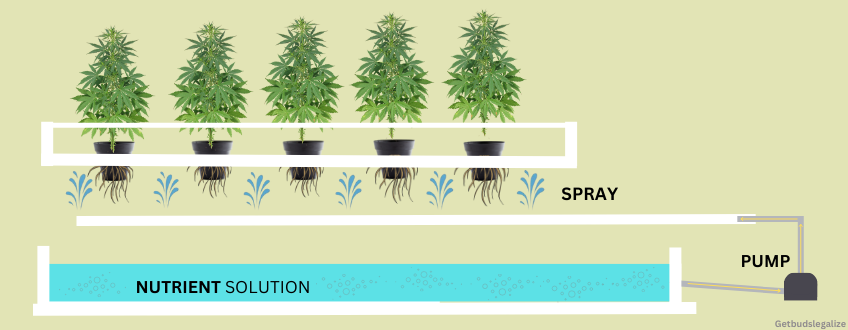
Aeroponic systems utilize misted water to provide aeration and hydration to the roots. Plants are suspended above a water tank, with misters beneath the root systems dispersing fine mist. This innovative approach optimizes air and water delivery, fostering robust plant growth.
Preparing Your Hydroponic System for Optimal Plants Growth
After selecting your hydroponic system, ensuring successful growth requires proactive measures. The moist and dark environment within water tanks can foster the growth of pathogens. To prevent contamination, sterilize your equipment before starting the system. Clean buckets, trays, pipes, and tanks thoroughly using rubbing alcohol, hot water, and peroxide. Follow setup instructions meticulously to optimize your system.
Regular Maintenance Matters
Consistent upkeep of your hydroponic system is crucial for maintaining an optimal growing environment. Key factors to monitor include:
A: Continuous pH Monitoring:
Regularly test the water’s pH to maintain an ideal growing environment. Aim for a slightly acidic pH range of 5.5–5.8, adjusting it to 6 during the flowering phase.
B: Water Temperature Maintenance:
Maintain water temperature around 20°C, ideal for hydroponic cannabis growth. Use a water thermometer and employ a water heater if temperatures drop too low.
C: Nutrient Management:
Simplify feeding by using hydroponic nutrient solutions covering all necessary substances for both vegetative and flowering phases. Follow product instructions for nutrient addition frequency and dilution.
D: Cleanliness:
Regularly clean growing trays and tanks every two weeks to prevent pathogen buildup. Revisit the sterilization process during these cleanings.
E: Strain Selection for Hydroponic Growing
Choosing the right strain is crucial for hydroponic cultivation. Opt for smaller, compact strains, especially in indoor grow tents, to maximize yield and space efficiency. Consider Northern Lights, known for its compact stature and rapid growth, and White Widow, favored for its balanced effects and resilience to stress and diseases. These strains are excellent choices for maximizing yield and efficiency in your hydroponic garden.
How to Prepare a Hydroponic Setup for Growing Cannabis
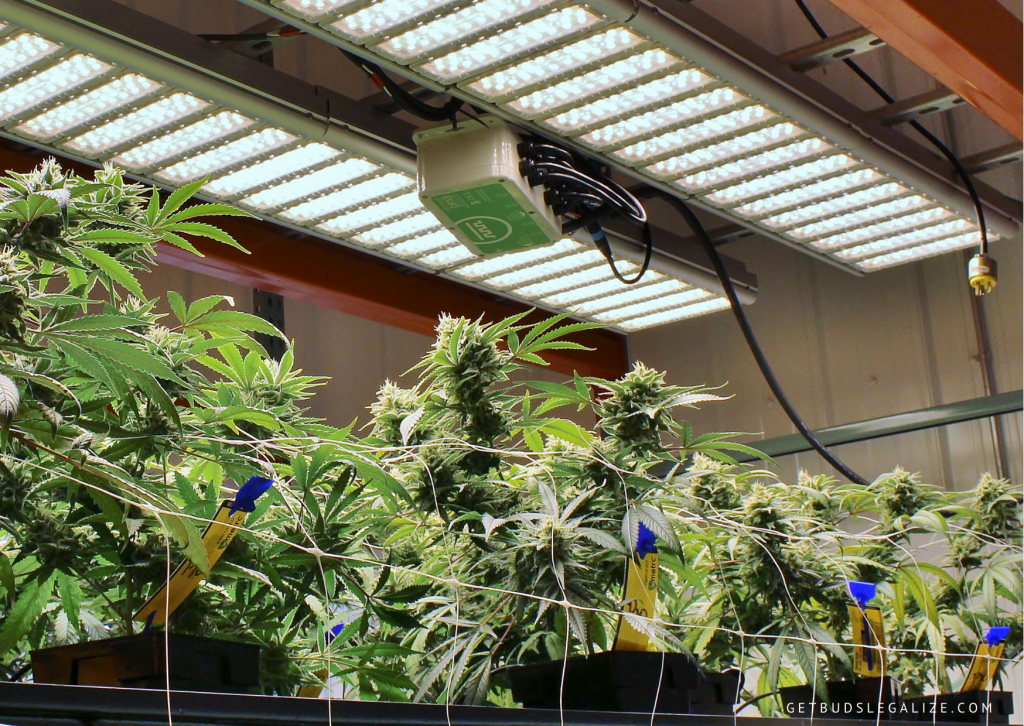
Now that you have your hydroponic system and growing medium sorted, it’s time to prepare your setup for planting cannabis. Follow these steps to get your hydroponic garden up and running:
- Clean and sanitize your hydroponic system to remove any dirt, debris, or pathogens that could harm your plants. Use a mild detergent or hydrogen peroxide solution to disinfect all components thoroughly.
- Fill your reservoir with water and add hydroponic nutrients according to the manufacturer’s instructions. Use a pH meter to adjust the level of the pH of the nutrient solution to the optimal range for cannabis cultivation (usually between 5.5 and 5.8).
- Place your chosen growing medium in net mesh planting pots and insert them into the hydroponic tray or reservoir. Make sure the medium is evenly distributed and the pots are stable.
- Plant your cannabis seeds or clones in the center of each planting pot, ensuring they are positioned at the correct depth and orientation. Cover the seeds with a thin layer of growing medium and gently water them to initiate germination.
- Turn on your air pump and air stone to oxygenate the nutrient solution and promote healthy root growth. Monitor the temperature and humidity levels in your grow room to create an optimal environment for cannabis cultivation.
- Adjust the height and intensity of your grow lights to provide the right amount of light for your cannabis plants at each stage of growth. Use a timer to automate the light cycle and ensure consistent photoperiods for flowering.
- Monitor the nutrient levels, pH balance, and water temperature in your hydroponic system regularly to prevent nutrient deficiencies, pH fluctuations, and root rot. Make adjustments as needed to maintain optimal growing conditions for your cannabis plants.
Hydroponic Marijuana Grow Guide Week by Week
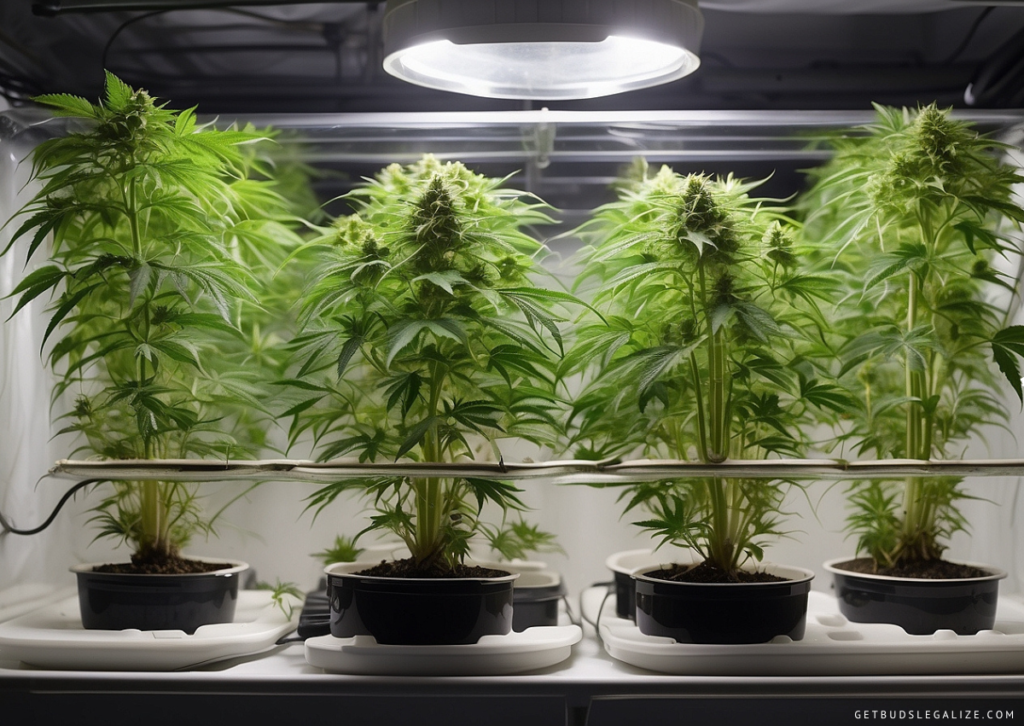
Here’s a week-by-week guide for hydroponic cannabis growing, including monitoring and adjusting EC (electrical conductivity) and pH levels:
Week 1-2: Germination and Seedling Stage
- EC: Start with a low EC level of around 0.4-0.6 mS/cm (millisiemens per centimeter) for seedlings.
- pH: Aim for a pH range of 5.5-5.8 for optimal nutrient uptake during this early stage.
- Keep the nutrient solution oxygenated and ensure proper humidity and temperature for seedling growth.
- Monitor the seedlings closely for signs of overwatering or nutrient deficiencies.
Week 3-4: Vegetative Growth
- EC: Gradually increase the EC level to around 0.8-1.2 mS/cm to support vegetative growth.
- pH: Maintain pH in the range of 5.5-5.8, adjusting as needed to prevent a nutrient lockout.
- Provide adequate lighting and airflow to promote healthy vegetative growth.
- Monitor plant growth and adjust nutrient levels accordingly to prevent nutrient burn or deficiencies.
Week 5-6: Early Flowering Phase
- EC: Increase the EC level to around 1.2-1.5 mS/cm as plants transition into the flowering stage.
- pH: Continue monitoring and adjusting pH within the range of 5.5-6.0 to ensure proper nutrient uptake.
- Adjust lighting schedules to induce flowering and provide support for developing buds.
- Monitor plant health and adjust nutrient levels as needed to prevent nutrient imbalances.
Week 7-8: Mid-Flowering Phase
- EC: Maintain EC levels between 1.5-2.0 mS/cm to support flower development and maximize yield.
- pH: Keep the levels of the pH stable within the range of 5.5-6.5 to prevent nutrient deficiencies or toxicities.
- Provide proper support for heavy buds and monitor for signs of nutrient deficiencies or pest infestations.
- Consider flushing plants with plain water if EC levels become too high or nutrient buildup occurs.
Week 9-10: Late Flowering Stage and Ripening
- EC: Gradually reduce EC levels to around 1.0-1.5 mS/cm as plants near harvest to prevent nutrient buildup.
- pH: Continue monitoring pH and adjust as needed to optimize nutrient uptake during the ripening phase.
- Monitor trichome development and overall plant health to determine the optimal time for harvest.
- Consider flushing plants with plain water during the final weeks to improve flavor and aroma.
Week 11-12: Harvest and Post-Harvest Care
- Flush the plants with plain water to remove any excess nutrients and improve the quality of the final product.
- Harvest the plants when trichomes are at their peak potency and aroma.
- Dry and cure the harvested buds properly to preserve flavor, potency, and aroma.
- Clean and sanitize the hydroponic system thoroughly before starting a new growing cycle.
Throughout the entire growing process, it’s essential to monitor environmental conditions, such as temperature, humidity, and airflow, to create an optimal growing environment for your cannabis plants. Additionally, regularly check the pH and EC levels of the nutrient solution and adjust them as needed to maintain optimal nutrient uptake and plant health. Happy growing!
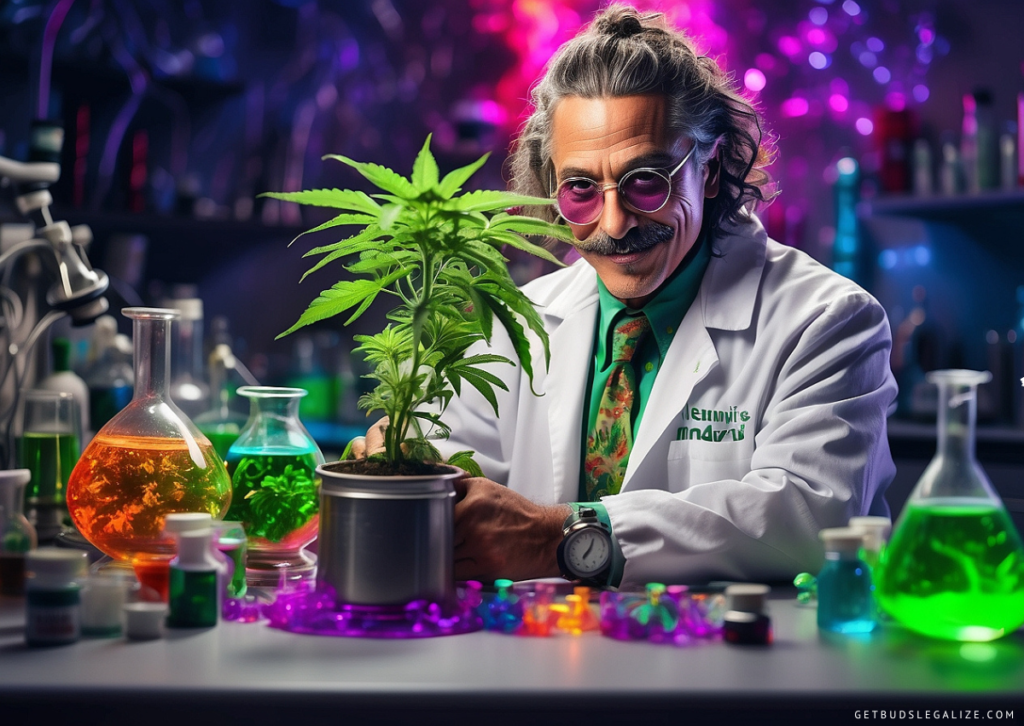
Conclusion
Cannabis hydroponic growing offers many advantages over traditional soil cultivation, including faster growth, higher yields, and better control over environmental factors.
By choosing the right hydroponic system and growing medium for your needs, you can create an ideal growing environment for cannabis plants and produce top-quality buds with ease. Whether you’re a novice grower or an experienced cultivator, hydroponic growing provides a rewarding and efficient way to cultivate cannabis indoors.
Remember to start small and experiment with different hydroponic systems and techniques to find what works best for you. With patience, practice, and a little bit of trial and error, you can become a successful hydroponic grower and enjoy a bountiful harvest of homegrown cannabis. Happy growing!
FAQs about Marijuana Hydroponic Growing
Hydroponics is a method of cultivating cannabis plants without soil, using nutrient-rich water solutions to deliver essential nutrients directly to the plant roots.
The hydroponic method offers precise control over nutrient intake, resulting in plants that grow faster growth and potentially higher yields compared to traditional soil methods.
Yes, you can grow “organic” cannabis using hydroponic methods. While the term “organic” typically refers to the use of natural inputs and processes without synthetic chemicals, it’s important to note that the definition and certification of organic cannabis may vary depending on regional regulations and certifying bodies.
In hydroponic systems, organic practices can include using organic nutrient solutions derived from natural sources, such as compost teas, fish emulsions, seaweed extracts, and other organic amendments. Additionally, you can incorporate organic growing mediums like coco coir or organic rock wool cubes.
To ensure your hydroponically grown cannabis is organic, it’s essential to research and select organic-certified nutrients and supplements, monitor the quality of water sources, maintain proper pH and EC levels, and follow organic growing principles throughout the cultivation process.
Additionally, some certification bodies may have specific guidelines for hydroponic organic production that you’ll need to adhere to.
Hydroponic systems can accelerate growth by providing plants with optimal nutrient levels, oxygenation, and environmental conditions, leading to faster growth rates compared to soil cultivation.
Although not essential, utilizing a controlled environment can enhance hydroponic cannabis growth by facilitating easier regulation of factors such as temperature, humidity, and lighting.
Cannabis hydroponics requires a balanced mix of essential nutrients including nitrogen, phosphorus, potassium, calcium, magnesium, and trace elements like iron, zinc, and copper.
The optimal frequency for changing the nutrient solution in a hydroponic system varies based on factors such as plant growth stage, system type, and water quality. As a general guideline, it is recommended to change the solution every 1-2 weeks to ensure optimal plant health and nutrient uptake.
Challenges can include maintaining proper nutrient levels, preventing diseases like root rot, managing pH and EC levels, and ensuring adequate ventilation and lighting for healthy growth. Regular monitoring and adjustment are crucial.
Yes, hydroponic systems can be used to grow medical marijuana, providing a controlled environment for consistent quality and potency of medicinal products.
While specialized equipment like pumps, reservoirs, grow lights, and pH/EC meters are beneficial, basic hydroponic setups can be relatively simple and affordable, depending on the scale of your operation.
Preventive measures include maintaining a clean growing environment, using sterile equipment, monitoring plant health regularly, and implementing integrated pest management (IPM) strategies if issues arise.
Common mistakes include neglecting pH and EC levels, overfeeding or underfeeding plants, insufficient aeration of the root zone, inadequate lighting or ventilation, and poor water quality. Regular monitoring and adjustment can help avoid these issues.
The optimal EC (Electrical Conductivity) level for flushing cannabis in a hydroponic system typically ranges between 0.0 and 0.4 mS/cm (millisiemens per centimeter).
During the flushing process, it’s essential to use plain water with minimal to no nutrient content.
Monitoring the EC level of the water runoff can help ensure that excess nutrients are being effectively removed from the growing medium and roots.
As the flushing progresses, the EC level of the runoff should decrease, indicating that nutrient buildup is being flushed out.
ILGM Fertilizer
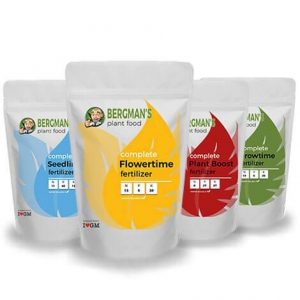
- From seedling to harvest, give your plants everything they need.
- Enough for feeding at least 5 plants.
- Discounted Package Deal
- Works well in soil, hydroponics, and other growing mediums.
- The best way to treat your plants
ILGM Plant Protector
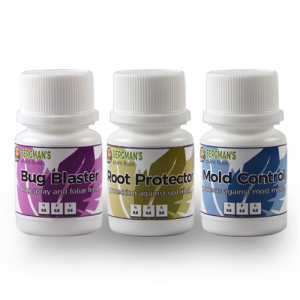
- Protect your cannabis from diseases and harmful pests.
- Contains three 20 ml bottles.
- Enough supplies to protect 20 plants.
- It can be used in soil, hydroponic, and all other growing mediums.
















